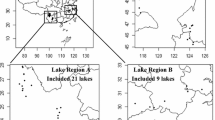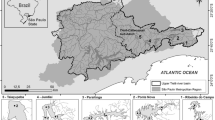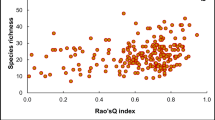Abstract
The use of lower taxonomic resolutions and ecological classifications can function as a strategy to minimize difficulties in plankton identification. To assess this issue, we evaluated the concordance of the spatial ordering of lakes in a floodplain using phytoplankton and zooplankton densities scaled at three taxonomic levels (species, genus, and family) and two exclusive ecological classifications for phytoplankton [Reynolds functional groups (RFGs) and morphology-based functional groups]. Furthermore, we evaluated the concordance of environmental variables with each taxonomic resolution/ecological classification. Procrustes and Mantel tests (simple and partial) were used for the concordance analysis. The correlations between species and higher taxonomic levels were found for phytoplankton and zooplankton. For the ecological classifications, significant r values, greater than 0.70, were obtained only for the Mantel test between species and RFGs. The relationship between species and genus and between species and family for phytoplankton can be explained by the environmental structure. For zooplankton, only species were related to environmental variables. These results indicate that it is possible to adopt a lower taxonomic resolution for identification of phytoplankton and zooplankton without a significant loss of information. However, the use of ecological classifications for phytoplankton is not recommended for this purpose.




Similar content being viewed by others
References
Adler, P. H. & D. C. Currie, 1986. Taxonomic resolution of the 3 new species near Simulium vernum Macquart (Diptera, Simuliidae). Canadian Entomologist 118: 1207–1220.
Allan, J. D., 1976. Life history patterns in zooplankton. The American Naturalist 110: 165–180.
Anderson, M. J., S. D. Connel, B. M. Gillanders, C. E. Diebel, W. M. Blom, J. E. Saunders & T. J. Landers, 2005. Relationships between taxonomic resolution and spatial scales of multivariate variation. Journal of Animal Ecology 74: 636–646.
Aquino, S., E. M. Latrubesse & E. E. D. Filho, 2008. Relações entre o regime hidrológico e os ecossistemas aquáticos da planície aluvial do rio Araguaia. Acta Scientiarium Biological Sciences 30: 361–369.
Azémar, F., T. Maris, B. Mialet, H. Segers, S. Van Damme, P. Meire & M. Tackx, 2010. Rotifers in the Schelde estuary (Belgium): a test of taxonomic relevance. Journal of Plankton Research 32: 981–997.
Balmford, A., M. J. B. Green & M. G. Murray, 1996. Using higher-taxon richness as a surrogate for species richness: I. Regional tests. Proceedings of the Royal Society of London 263: 1267–1274.
Bayley, P. B., 1995. Understanding large river: floodplain ecosystems. Bioscience Journal 45: 153–158.
Becker, V., L. Caputo, J. Ordónez, R. Marce, J. Armengol, L. O. Crossetti & V. L. M. Huszar, 2010. Driving factors of the phytoplankton functional groups in a deep Mediterranean reservoir. Water Research 44: 3345–3354.
Beisner, B. E., P. R. Peres, E. S. Lindstrom, A. Barnett & M. L. Longhi, 2006. The role of environmental and spatial processes in structuring lake communities from bacteria to fish. Ecology 87: 2985–2991.
Benfield, M. C., P. Grosjean, P. F. Culverhouse, X. Irigoien, M. E. Sieracki, A. Lopez-Urrutia, H. G. Dam, E. M. Riseman, H. Schultz, P. E. Utgoff & G. Gorsky, 2007. Research on automated plankton identification. Oceanography 20: 172–187.
Bessa, G. F., L. C. G. Vieira, L. M. Bini, D. F. R. Reis & P. B. Morais, 2011. Concordance patterns in zooplankton assemblages in the UHE-Luís Eduardo Magalhães reservoir in the Mid-Tocantins river, Tocantins State, Brazil. Acta Scientiarium Biological Sciences 33: 179–184.
Bini, L. M., L. C. F. Silva, L. F. M. Velho, C. C. Bonecker & F. A. Lansac-Tôha, 2008. Zooplankton assemblage concordance patterns in Brazilian reservoirs. Hydrobiologia 598: 247–255.
Bini, L. M., L. C. G. Vieira, J. Machado & L. F. M. Velho, 2007. Concordance of species composition patterns among microcrustaceans, rotifers and testate amoebae in a shallow pond. International Review of Hydrobiology 92: 9–22.
Bottrell, H. H., A. Duncan, Z. M. Gliwicz, E. Grygierek, A. Herzig, A. Hillbrichtilkowska, H. Kurasawa, P. Larsson & T. Weglenska, 1976. Review of some problems in zooplankton production studies. Norwegian Journal of Zoology 24: 419–456.
Brasil, J. & V. L. M. Huszar, 2011. O papel dos traços funcionais na ecologia do fitoplâncton continental. Oecologia Australis 15: 799–834.
Calijuri, M. C. & A. C. A. Dos Santos, 1996. Short-term changes in the Barra Bonita reservoir (São Paulo, Brazil): emphases in the phytoplankton communities. Hydrobiologia 330: 163–175.
Calijuri, M. C., A. C. D. Dos Santos & S. Jati, 2002. Temporal changes in the phytoplankton community structure in a tropical and eutrophic reservoir (Barra Bonita, S.P. Brazil). Journal of Plankton Research 24: 617–634.
Carneiro, F. M., L. M. Bini & L. C. Rodrigues, 2010. Influence of taxonomic and numerical resolution on the analyses of temporal changes in phytoplankton communities. Ecological Indicators 10: 249–255.
Carneiro, F. M., J. C. Nabout, L. C. G. Vieira, S. Lodi & L. M. Bini, 2013. Higher taxa predict plankton beta-diversity across in eutrophication gradient. Natureza & Conservação 11: 43–47.
Corbi, J. J. & S. Trivinho-Strixino, 2006. Influence of taxonomic resolution of stream macroinvertebrate communities on the evaluation of different land uses. Acta Limnologica Brasiliensis 18: 469–475.
Dussart, B. H. & S. M. Frutos, 1985. Sur quelques copépodes d’Argentine. Revista de Biologia Tropical 18: 305–314.
Elmoor-Loureiro, L. M. A., 1997. Manual de Identificação de Cladóceros Límnicos do Brasil. Editora Universa, Brasília.
Espíndola, E. G., T. Matsumura-Tundisi & I. D. Moreno, 1996. Estrutura da comunidade fitoplanctônica da lagoa Albuquerque (Pantanal Mato-grossense), Mato Grosso do Sul, Brasil. Acta Limnologica Brasiliensia 8: 13–27.
Ferrareze, M., 2012. The effect of the land use on phytoplankton assemblages of a Cerrado stream (Brazil). Acta Limnologica Brasiliensia 24: 43–51.
Gallego, I., T. A. Davidson, E. Jeppesen, C. Pérez-Martínez, P. Sánchez-Castillo & M. Juan, 2012. Taxonomic or ecological approaches? Searching for phytoplankton surrogates in the determination of richness and assemblage composition in ponds. Ecological Indicators 18: 575–585.
Gauthier-lievre, L. & R. Thomas, 1958. Le genres Difflugia, Pentagonia, Maghrebia et Hoogenraadia (Rhizopodes Testacès) en Afrique. Archiv fur Protistenkunde 103: 1–370.
Golterman, H. L., R. S. Clymo & M. A. M. Ohnstad, 1978. Methods for Physical and Chemical Analysis of Freshwaters. Blackwell Scientific Publication, Oxford.
Guzmán-Alvis, A. I. & F. Carrasco, 2005. Taxonomic aggregation and redundancy in a tropical macroinfaunal assemblage of the southern Carribean in the detection of temporal patterns. Scientia Marina 69: 133–141.
Havens, K. E. & J. R. Beaver, 2011. Body size versus taxonomy in relating crustacean zooplankton communities to water quality in lakes. Inland Waters 1: 107–112.
Heino, J., 2010. Are indicator groups and cross-taxon congruence useful for predicting biodiversity in aquatic ecosystems? Ecological Indicators 10: 112–117.
Heino, J. & J. Soininen, 2007. Are higher taxa adequate surrogates for species-level assemblage patterns and species richness in stream organisms. Biological Conservation 137: 78–89.
Hill, B. H., R. J. Stevenson, Y. Pan, A. T. Herlihy, P. R. Kaufmann & C. B. Johnson, 2001. Comparison of correlations between environmental characteristics and stream diatom assemblages characterized at genus and species levels. Journal of the North American Benthological Society 20: 299–310.
Hirst, A. J., 2006. Influence of taxonomic resolution on multivariate analyses of arthropod and macroalgal reff assemblages. Marine Ecology Progress Series 324: 83–93.
Hunt, B. P. V. & G. W. Hosie, 2008. Southern ocean biogeography and taxonomic resolution: what’s in the name? Marine Biology 155: 191–203.
Irfanullah, H. M., 2006. Algal taxonomy in limnology: an example of the declining trend of taxonomic studies? Hydrobiologia 559: 1–9.
Jungbluth, M. J., E. Goetze & P. H. Lenz, 2013. Measuring copepod naupliar abundance in a subtropical bay using quantitative PCR. Marine Biology 160: 3125–3314.
Khan, S. J., 2006. Is species level identification essential for environmental impact studies? Current Science 91: 29–34.
Koste, W., 1972. Rotatorien aus Gewassern Amazoniens. Amazoniana 3: 258–505.
Koste, W., 1978. Rotatoria. Die Rädertiere Mitteleuropas. Bestimmungswerk begründet von Max Voigt, 2 Vols. Borntraeger, Sttutgart.
Kruk, C., V. L. M. Huszar, E. T. H. M. Peeters, S. Bonilla, L. Costa, M. Lurling, C. S. Reynolds & M. Scheffer, 2010. A morphological classification capturing functional variation in phytoplankton. Freshwater Biology 55: 614–627.
Lansac-Tôha, F. A., C. C. Bonecker, L. F. M. Velho, N. R. Simões, J. D. Dias, G. M. Alves & E. M. Takahashi, 2009. Biodiversity of zooplankton communities in the Upper Paraná River floodplain: interannual variation from long-term studies. Brazilian Journal of Biology 69: 539–549.
Latrubesse, E. M. & J. C. Steuvax, 2006. Características físico-bióticas e problemas ambientais associados à planície de inundação do Rio Araguaia, Brasil Central. Revista UnG Geociências 5: 65–73.
Legendre, P. & L. Legendre, 1998. Numerical Ecology. Elsevier Science, Amsterdam.
Legendre, P. & M. J. Fortin, 1989. Spatial pattern and ecological analysis. Vegetatio 80: 107–138.
Leibold, M. A., M. Holyoak, N. Mouquet, P. Amarasekare, J. M. Chase, M. F. Hoopes, R. D. Holt, J. B. Shurin, R. Law, D. Tilman, M. Loreau & A. Gonzale, 2004. The metacommunity concept: a framework for multi-scale community ecology. Ecology Letters 7: 601–613.
Lovell, S., M. Hamer, R. Slotow & D. Hebert, 2007. Assessment of congruency across invertebrate taxa and taxonomic levels to identify potential surrogates. Biological Conservation 139: 113–125.
Matsumura-Tundisi, T., 1986. Latitudinal distribution of Calanoida copepods in freshwater aquatic systems of Brazil. Revista Brasileira de Biologia 46: 527–553.
Melo, A. S., 2005. Effects of taxonomic and numerical resolution on the ability to detect ecological patterns at a local scale using stream macroinvertebrates. Archiv für Hydrobiologie 164: 309–323.
Melo, S. & V. L. M. Huszar, 2000. Phytoplankton in an Amazonian flood-plain lake (Lago Batata), Brazil. Journal of Plankton Research 22: 63–76.
Nabout, J. C., I. S. Nogueira & L. G. Oliveira, 2006. Phytoplankton community of floodplain lakes of the Araguaia river, Brazil, in the rainy and dry seasons. Journal of Plankton Research 28: 181–193.
Nabout, J. C., I. S. Nogueira, L. G. Oliveira & R. R. Morais, 2007. Phytoplankton diversity (alpha, beta, and gamma) from the Araguaia river tropical floodplain lakes (central Brazil). Hydrobiologia 557: 455–461.
Nabout, J. C., T. Siqueira, L. M. Bini & I. S. Nogueira, 2009. No evidence for environmental and spatial process in structuring phytoplankton communities. Acta Oecologica (Montrouge) 35: 720–726.
Nekola, J. & P. S. White, 1999. The distance decay of similarity in biogeography and ecology. Journal Biogeography 26: 867–878.
Ogden, C. G. & R. H. Hedley, 1980. An atlas of Freshwater Testate Amoebae. Oxford University Press, London.
Oksanen, J., F. G. Blanchet, R. Kindt, P. Legendre, P. R. Minchin, R. B. O’hara, G. L. Simpson, P. Solymos, M. H. H. Stevens & H. Wagner, 2013. Vegan: community ecology package. R package version 2.0-6. [http://CRAN.R-project.org/package=vegan]. Accessed 1 September 2013.
Padisák, J., L. O. Crossetti & L. Naselli-Flores, 2009. Use and misuse in the application of the phytoplankton functional classification: a critical review white updates. Hydrobiologia 621: 1–19.
Paggi, J. C., 1979. Revision de las especies argentinas del genero Bosmina Baird agrupadas en el subgenero Neobosmina Lider (Crustacea, Cladocera). Acta Zoologica Lilloana 35: 137–162.
Peura, S., A. Eiler, M. Hiltunen, H. Nykanen, M. Tiirola & R. I. Jones, 2012. Bacterial and phytoplankton responses to nutrient amendments in a boreal lake differ according to season and to taxonomic resolution. PLoS One 7: 1–12.
R Core Team, 2012. R: a language and environment for statistical computing. R Foundation for Statistical Computing, Vienna. [http://www.R-project.org/.”2012]. Accessed 1 September 2013.
Reid, J. W., 1985. Chave de identificação e lista de referências bibliográficas para as espécies continentais sulamericanas de vida livre da Ordem Cyclopoida (Crustacea, Copepoda). Boletim de Zoologia 9: 17–143.
Reynolds, C. S., V. L. M. Huszar, C. Kruk, L. Naselli-Flores & S. Melo, 2002. Review: towards a functional classification of the freshwater phytoplankton. Journal of Plankton Research 24: 417–428.
Rimet, F. & A. Bouchez, 2012. Biomonitoring river diatoms: implications of taxonomic resolution. Ecological Indicators 15: 92–99.
Rojo, C. & J. Rodríguez, 1994. Seasonal variability of phytoplankton size structure in a hypertrophic lake. Journal of Plankton Research 16: 317–335.
Round, F. E., 1965. The Biology of the Algae. Edward Arnold (Publishers) Ltd, London.
Round, F. E., 1971. The taxonomy of the Chlorophyta II. British Phycological Journal 6: 235–264.
Round, F. E., R. M. Crawford & D. G. Mann, 1990. Diatoms: Biology and Morphology of the Genera. Cambridge University Press, Cambridge.
Ruttner-Kolisko, A., 1989. Problems in taxonomic of rotifers, exemplified by the Filinia longiseta—terminalis complex. Hydrobiologia 186(187): 291–298.
Sánchez-Moyano, J. E., D. A. Fa, F. J. Estácio & J. C. García-Gómez, 2006. Monitoring of marine benthic communities and taxonomic resolution: an approach through diverse habitats and substrates along the Southern Iberian coastline. Helgoland Marine Research 60: 243–255.
Segers, H., 1995. The Lecanidae (Monogononta). In Nogrady, T. & H. Dumont (eds), Rotifera 2. Guides to the Identification of the Microinvertebrates of the Continental Waters of the World 6. SPB Academic Publishing, The Hague: 1–226.
Simões, N. R., F. A. Lansac-Tôha, L. F. M. Velho & C. C. Bonecker, 2012. Intra and inter-annual structure of zooplankton communities in floodplain lakes: a long-term ecological research study. Revista de Biologia Tropical 60: 1819–1836.
Sprules, W. G., 1984. Towards an optimal classification of zooplankton for lake ecosystem studies. Verhandlungen des Internationalen Verein Limnologie 22: 320–325.
Tataranni, M., F. Maltagliati, A. Floris, A. Castelli & C. Lardicci, 2009. Variance estimate and taxonomic resolution: an analysis of macrobenthic spatial patterns at different scales in a Western Mediterranean coastal lagoon. Marine Environmental Research 67: 219–229.
Utermöhl, H., 1958. Zurvervoll kommung der quantitativen phytoplankton-methodik. Mitteilungen Internationale Vereinigung für Theoretische und Angewandte Limnologie 9: 1–38.
Vanderklift, M. A., T. J. Ward & C. A. Jacoby, 1996. Effect of reducing taxonomic resolution on ordinations detect pollution-induced gradients in macrobenthic infaunal assembleges. Marine Ecology Progress Series 136: 137–145.
Vollenweider, R. A., 1974. A Manual on Methods for Measuring Primary Production in Aquatic Environments. Blackwell Scientific Publications, London.
Vucetich, M. C., 1973. Estudio de tecamebianos argentinos, en especial los del dominio pampasico. Revista del Museo de la Plata 11: 287–332.
Walther, G. R., E. Post, P. Convey, A. Menzel, C. Parmesank, T. J. C. Beebee, J. M. Fromentin, O. Hoegh-Guldberg & F. Bairlein, 2002. Ecological responses to recent climate change. Nature 416: 389–395.
Wetzel, C. E., D. C. Bicudo, L. Ector, E. A. Lobo, J. Soininen, V. L. Landeiro & L. M. Bini, 2012. Distance decay of similarity in neotropical diatom comunities. PLoS One 7: 1–8.
Zagatto, E. A. G., A. O. Jacintho, B. F. Reis, F. J. Krug, H. Bergamin, L. C. R. Pessenda, J. Mortatti & M. F. Giné, 1981. Manual de análises de plantas empregando sistemas de injeção em fluxo. Universidade de São Paulo, Piracicaba.
Acknowledgements
We thank the anonymous reviewer for suggestions that improved previous version of this manuscript. KBM and PPB thank to Conselho Nacional de Desenvolvimento Científico e Tecnológico (CNPq) by AT-B scholarship and to Coordenação de Aperfeiçoamento de Pessoal de Nível Superior (CAPES) by master schorlarship (de pós-graduação em Recursos Naturais do Cerrado). VLMH and JCN also are funded by CNPq (process 309700/2013-2 and 306719/2013-4). Our work has been continuously supported by CNPq (project nº 563834/2010-2), Fundação de Amparo à Pesquisa do Estado de Goiás (FAPEG), and CAPES (Auxpe 2036/2013).
Author information
Authors and Affiliations
Corresponding author
Additional information
Handling editor: Karl E. Havens
Rights and permissions
About this article
Cite this article
Machado, K.B., Borges, P.P., Carneiro, F.M. et al. Using lower taxonomic resolution and ecological approaches as a surrogate for plankton species. Hydrobiologia 743, 255–267 (2015). https://doi.org/10.1007/s10750-014-2042-y
Received:
Revised:
Accepted:
Published:
Issue Date:
DOI: https://doi.org/10.1007/s10750-014-2042-y




